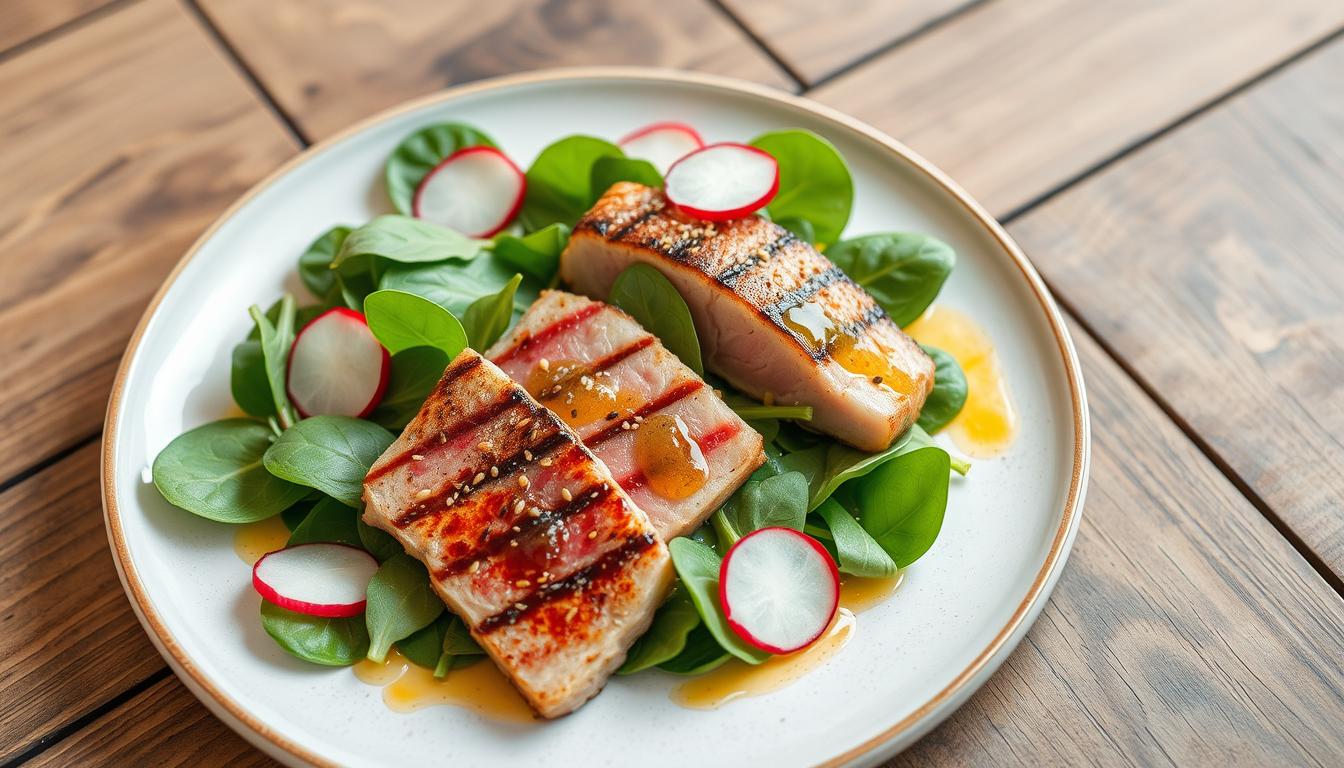Did you know adults need 35 grams of fiber daily to fight endometriosis symptoms? This endo-friendly seared tuna spinach recipe is a must-try for those with this chronic condition. It’s full of anti-inflammatory ingredients and omega-3 rich foods. This low-carb meal is a tasty way to nourish your body and ease endometriosis symptoms.
Managing endometriosis can be tough, but the right diet can help. We’ll look at the benefits of an anti-inflammatory diet and the importance of omega-3 foods. This simple yet flavorful seared tuna spinach recipe can become a key part of your endo-friendly kitchen.
What is an Endometriosis-Friendly Diet?
A special diet can help manage endometriosis by reducing inflammation and easing symptoms. This diet includes foods that fight inflammation, helping to control the condition.
Anti-inflammatory Foods for Endometriosis
To fight endometriosis inflammation, eat foods that are anti-inflammatory. Some great choices are:
- Omega-3 rich foods like fatty fish (such as salmon, mackerel, and sardines), walnuts, and flaxseeds
- Leafy green vegetables, such as spinach, kale, and arugula
- Berries, like blueberries and raspberries
- Turmeric, which has a strong anti-inflammatory compound called curcumin
- Ginger, which can help lessen menstrual cramps and pain
Importance of Omega-3 Rich Foods
Omega-3 fatty acids are key in an endometriosis-friendly diet. They help fight inflammation, which can ease pelvic pain and discomfort. Adding omega-3 rich foods like fatty fish, nuts, and seeds to your meals can greatly help manage symptoms.
By focusing on an anti-inflammatory diet and eating enough omega-3 rich foods, people with endometriosis can reduce inflammation. This can help slow down the disease’s progression. Eating a balanced, nutrient-rich diet is a powerful way to manage this complex condition.
Endo friendly seared tuna spinach
Our diet is key in managing endometriosis. The endometriosis-friendly recipe for seared tuna spinach is perfect for an anti-inflammatory diet. It’s full of endo friendly and anti-inflammatory ingredients that help ease symptoms and boost health.
The main ingredient, seared tuna, is rich in omega-3 fatty acids. These fats are known for their anti-inflammatory effects, making them great for the endometriosis diet. Plus, tuna has low mercury levels, making it safe for those with this condition.
Spinach, paired with tuna, adds to the dish’s nutritional value. It’s packed with antioxidants, fiber, iron, and essential vitamins and minerals that help manage endometriosis symptoms. Together, tuna and spinach make a balanced, endo friendly meal that supports health.
Adding this recipe to your diet is a step towards managing endometriosis. A balanced, anti-inflammatory diet is essential for improving health and well-being with endometriosis.
Benefits of Seared Tuna for Endometriosis
Adding seared tuna to your diet can help with endometriosis. Tuna is full of omega-3 fatty acids. These fats fight inflammation, which can ease endometriosis pain.
Omega-3 Fatty Acids in Tuna
Tuna is packed with omega-3s like EPA and DHA. These fats cut down on inflammation by stopping bad compounds. Eating seared tuna can help manage endometriosis pain and inflammation.
Low Mercury Content
Tuna has less mercury than other seafood. Mercury is bad, and too much can harm those with endometriosis. Seared tuna is a safe choice for its omega-3s and low mercury.
Seared tuna is great for endometriosis because of its omega-3s and low mercury. It’s a key part of a healthy diet for managing symptoms. Adding it to your meals can improve your health and well-being.
Nutritional Value of Spinach
Spinach is a nutritional powerhouse, making it great for those with endometriosis. It’s full of vitamins, minerals, and antioxidants. These help support health and manage endometriosis symptoms.
Spinach stands out for its nutrient-rich profile. It’s loaded with vitamins A, C, and K, folate, iron, and magnesium. These nutrients boost the immune system, reduce inflammation, and support tissue growth. All of these benefits are good for those with endometriosis.
Spinach is also packed with antioxidants like lutein and zeaxanthin. These fight oxidative stress and lower disease risk. Plus, it has omega-3 fatty acids, which are anti-inflammatory. They may help ease endometriosis pain and discomfort.
Adding spinach to your diet can be very beneficial. It’s part of a group of leafy greens for endometriosis and endometriosis-friendly vegetables. This can greatly improve your spinach nutrition and help manage your condition.
Low-FODMAP Diet for Endometriosis
Managing endometriosis often requires a multifaceted approach. One dietary strategy that has shown promise is the low-FODMAP diet. FODMAPs, or Fermentable Oligosaccharides, Disaccharides, Monosaccharides, and Polyols, are short-chain carbohydrates that can be hard to digest. This can lead to digestive issues.
What are FODMAPs?
FODMAPs are found in many foods, like grains, fruits, vegetables, dairy, and legumes. For those with endometriosis, who often face digestive symptoms like bloating and abdominal pain, a low-FODMAP diet can help. It limits high-FODMAP foods, which can reduce these uncomfortable symptoms and help manage endometriosis.
A study with 160 participants found that 72% of those with endometriosis saw over a 50% improvement in bowel symptoms after four weeks on a low-FODMAP diet. This shows that managing FODMAP intake can be a valuable tool in managing endometriosis.
Remember, the low-FODMAP diet should be discussed with a healthcare professional. It can be complex and may need the guidance of a registered dietitian or gastroenterologist to ensure proper implementation and long-term sustainability.
Gluten-Free Cooking for Autoimmune Conditions
People with autoimmune conditions like endometriosis might find relief in a gluten-free diet. Gluten, found in wheat, barley, and rye, can cause inflammation. Cutting out gluten can help reduce inflammation and ease endometriosis symptoms.
Starting a gluten-free diet might seem hard, but there are many tasty options. You can make oat porridge with berries or buckwheat pancakes. These are just a few ideas for gluten-free cooking that’s good for endometriosis.
When cooking gluten-free, choose foods that fight inflammation. Look for foods high in omega-3s, fiber, and antioxidants. Good choices include:
- Fatty fish like salmon, mackerel, and tuna
- Leafy green vegetables like spinach and kale
- Berries, such as blueberries and raspberries
- Nuts and seeds, including walnuts and chia seeds
- Turmeric and other anti-inflammatory herbs and spices
Using these gluten-free, autoimmune condition-friendly foods can boost your health. It may also help manage endometriosis symptoms better.
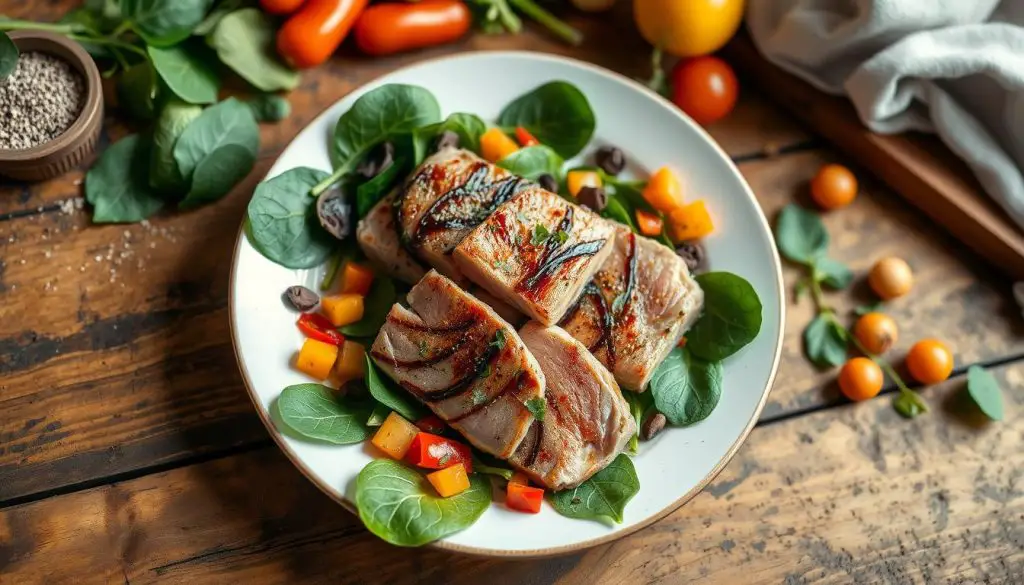
Every person is different, so it’s key to work with your healthcare team. They can help find the right gluten-free diet for your autoimmune condition. By choosing wisely, you can help manage your endometriosis and feel better overall.
Anti-Inflammatory Herbs and Spices
Incorporating anti-inflammatory herbs and spices into your diet can help manage endometriosis. Turmeric and its active compound, curcumin are two key ingredients to consider.
Turmeric and Curcumin
Turmeric, a bright yellow spice, is used in Indian and Middle Eastern cooking. It’s known for its anti-inflammatory properties. Curcumin, its main active compound, is what makes turmeric so beneficial.
Studies suggest curcumin can reduce inflammation and help with endometriosis symptoms. Adding turmeric and curcumin-rich foods to your diet can be a tasty way to fight inflammation. This could help ease endometriosis symptoms and improve your overall health.
Always talk to your healthcare provider before changing your diet, even for a chronic condition like endometriosis. They can help you find the best diet and self-management strategies for your symptoms.
Meal Preparation Tips
Following an endometriosis-friendly diet can greatly help manage symptoms. But, it needs some smart meal prep planning. By spending a bit of time upfront, we can make these changes easier to keep up with over time.
Batch cooking is a great time-saving cooking trick. Cooking big batches of healthy meals, like seared tuna and spinach, gives us quick options for the week. This way, we avoid rushing to unhealthy choices when we’re in a hurry.
Another good idea is to plan out our meals ahead of time. Just a few minutes each week to plan breakfast, lunch, and dinner can be a big help. It keeps us on track with our endometriosis diet and makes sure we have everything we need.
- Focus on consuming 6-9 cups of veggies a day.
- Prioritize protein-rich foods like sardines, salmon, heart, and liver.
- Avoid snacking and opt for larger, balanced meals instead.
- Start with perfecting breakfast, then add dinner, and incorporate leftovers for lunch.
Adopting a meal prep mindset can make managing endometriosis through diet much easier. By planning and using quick cooking methods, we can make healthy meals a regular part of our lives.
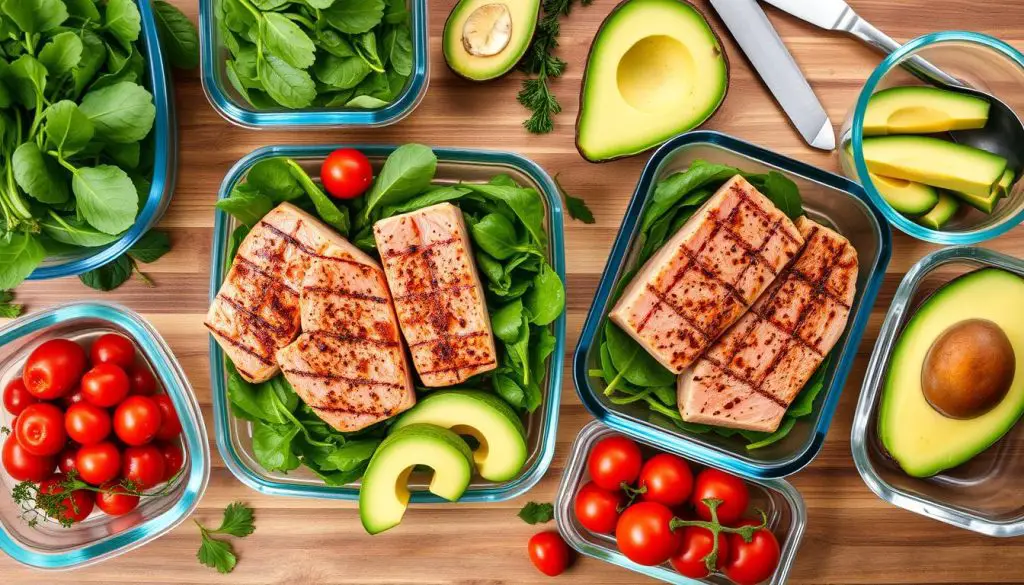
| Meal | Preparation Approach |
|---|---|
| Breakfast | Focus on protein for sustained blood sugar balance |
| Lunch | Predominantly leftovers, batch-cooked items, nori wraps, avocados, salmon, or sardines |
| Dinner | The main cooking event, with a mix of regular and quick meals |
Remember, the key to successful meal prep for an endometriosis diet is to see it as a lifestyle change, not just a quick fix. By focusing on planning, prepping, and batch cooking, we can make healthy meals a regular part of our daily lives.
Seared Tuna Spinach Recipe
Our seared tuna spinach recipe is perfect for those with endometriosis. It’s full of flavor and anti-inflammatory ingredients. These ingredients help manage symptoms of this chronic condition.
Ingredients
- 4 (6-ounce) tuna steaks
- 2 tablespoons olive oil
- 2 cloves garlic, minced
- 4 cups fresh spinach leaves
- 1 tablespoon lemon juice
- Salt and pepper to taste
Instructions
- Pat the tuna steaks dry and season them with salt and pepper on both sides.
- Heat the olive oil in a large skillet over high heat. When the oil is hot, add the tuna steaks and sear for 2-3 minutes per side, or until the outside is crispy and the inside is slightly pink.
- Remove the tuna steaks from the skillet and set them aside.
- In the same skillet, sauté the garlic for 1 minute until fragrant.
- Add the fresh spinach leaves and sauté for 2-3 minutes, until the spinach is wilted.
- Drizzle the lemon juice over the spinach and toss to combine.
- Serve the seared tuna steaks on a bed of the garlicky spinach.
This seared tuna spinach recipe is tasty and endometriosis-friendly. It’s also good for your health. Tuna has omega-3 fatty acids that fight inflammation. Spinach is full of vitamins, minerals, and antioxidants.
Try our seared tuna spinach recipe for a delicious, endometriosis-friendly meal. It will nourish your body and help manage your symptoms.
Healthy Protein Sources for Endometriosis
Managing endometriosis means eating a balanced, anti-inflammatory diet. Finding the right protein sources is key. Protein helps with tissue repair, hormone balance, and immune health. These are all important for those with endometriosis.
So, what are some good protein sources for endometriosis? Let’s look at a few:
- Lean Poultry: Chicken and turkey are great for a balanced diet. They’re easy to add to many meals.
- Fatty Fish: Salmon, tuna, and other fatty fish are full of omega-3s. These fats fight inflammation and help with symptoms.
- Legumes: Beans, lentils, and other legumes are packed with protein and fiber. They help with digestion and gut health.
- Nuts and Seeds: Almonds, walnuts, chia seeds, and flaxseeds are rich in protein and healthy fats. They also have magnesium and zinc.
- Eggs: Eggs are versatile and full of nutrients. They’re easy to add to many meals and snacks.
The endometriosis diet should focus on healthy protein sources. These foods help reduce inflammation and support your health. Adding these protein-rich foods to your meals can help manage your endometriosis and improve your life.
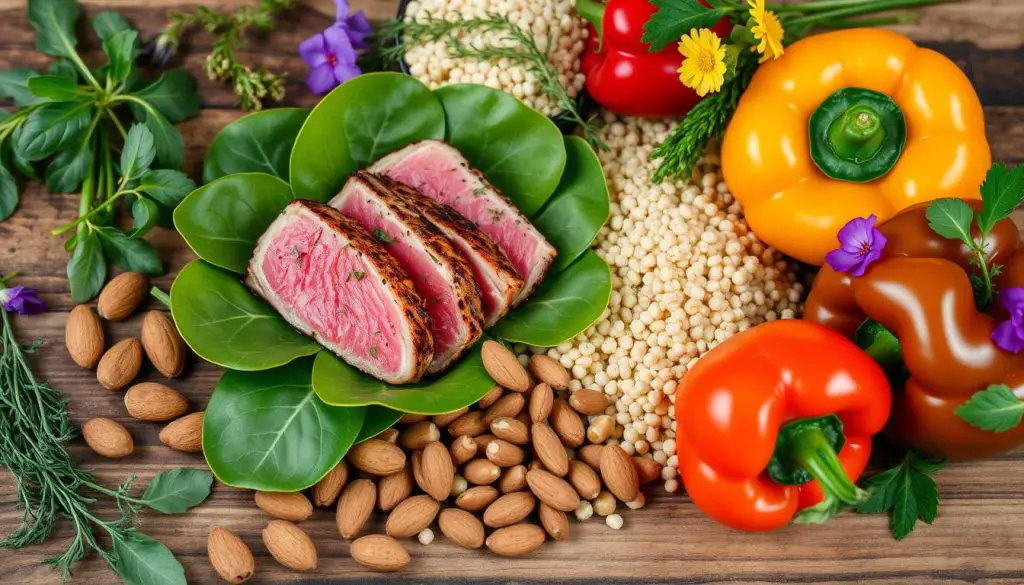
Leafy Green Vegetables for Endometriosis
Living with endometriosis means we need to eat well to feel better. Leafy green vegetables are key in this fight. They help us manage symptoms and stay healthy.
Leafy greens like spinach, kale, arugula, and Swiss chard are full of nutrients. They fight inflammation and help our bodies heal. These veggies are packed with antioxidants and vitamins C and E.
- Spinach is rich in iron, important for those with endometriosis who might have low iron.
- Kale is full of fiber, which can lower estrogen and ease symptoms.
- Arugula has nitrates that can improve blood flow and reduce pain.
- Swiss chard is a good source of magnesium, helping with cramps and muscle tension.
Adding these leafy greens to our diet can change our lives. They’re full of vitamins, minerals, and antioxidants. These nutrients support our health and well-being.
A diet rich in leafy greens and other anti-inflammatory foods is powerful. It helps manage endometriosis and improves our life quality. Let’s make leafy greens a big part of our journey!
Endometriosis Management Through Diet
Endometriosis is a chronic condition that affects millions of women. There’s no single cure, but diet changes can help manage symptoms. An anti-inflammatory diet rich in nutrients can reduce discomfort and improve well-being.
An endometriosis-friendly diet focuses on anti-inflammatory foods. Omega-3 fatty acids in oily fish, chia seeds, and walnuts help reduce symptoms. Antioxidants like flavonoids, vitamins C and E in fruits and veggies also fight inflammation.
- Aim for at least 35 grams of fiber daily to manage endometriosis. Ground flaxseed is a good source, but limit to 3 tablespoons a day.
- Keep saturated fat intake under 10% of daily calories and caffeine under 400 milligrams to help manage endometriosis.
- Limit sugar intake to less than 26 grams a day to reduce inflammation.
- Eat poultry, red meat, and shellfish to get enough zinc for hormonal balance.
While there’s no one diet for everyone, some find relief on a gluten-free or dairy-free diet. Always talk to a healthcare professional before making big diet changes or taking supplements.
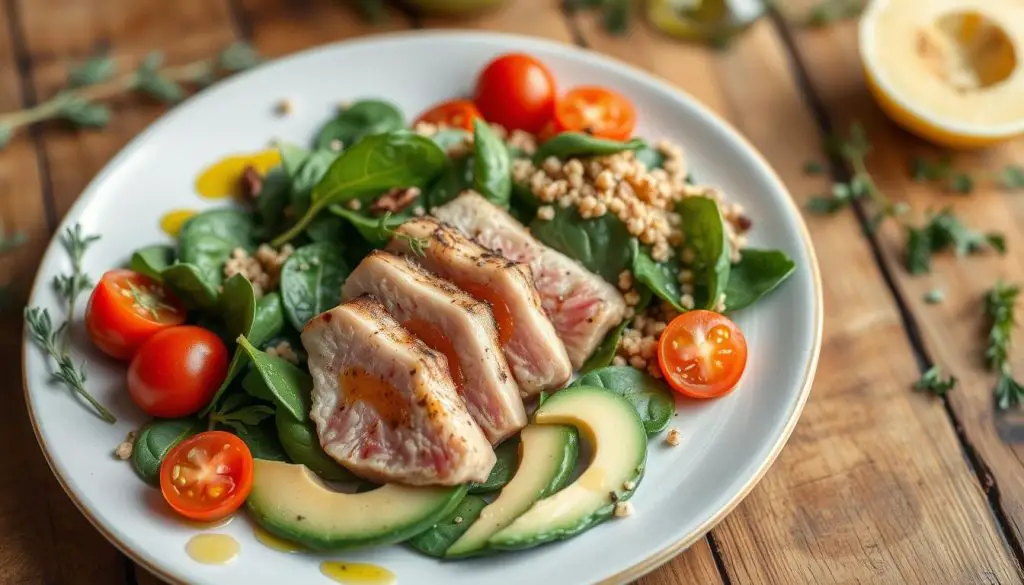
By following these dietary tips and trying endometriosis-friendly recipes, you can manage your condition. A balanced diet, exercise, and stress management are key in managing endometriosis.
Autoimmune-Friendly Cuisine Ideas
We’ve learned how key an endometriosis-friendly diet is. It’s all about using autoimmune-friendly cooking and recipes. This helps our body heal and manage symptoms better.
Adopting an endometriosis diet based on the Autoimmune Paleo (AIP) protocol is a good idea. It focuses on whole foods like veggies, fruits, healthy fats, and quality proteins. These foods are full of nutrients and low in triggers.
We can also try anti-inflammatory recipes. These use ingredients like turmeric, ginger, and omega-3s. These dishes are tasty and good for us, helping us manage endometriosis symptoms.
Source Links
- https://health.clevelandclinic.org/endometriosis-diet
- https://www.healendo.com/food-inspo
- https://www.lybrate.com/topic/adenomyosis-diet
- http://www.endometriosis.co.uk/oslo2018handout.pdf
- https://www.health.com/condition/endometriosis/endometriosis-diet
- https://sofreshnsogreen.com/recipes/luteal-phase-foods/
- https://www.everydayhealth.com/mediterranean-diet/complete-mediterranean-diet-food-list-day-meal-plan/
- https://jackkruse.com/my-leptin-prescription/
- https://www.medicalnewstoday.com/articles/interstitial-cystitis-diet
- https://www.crohnscolitisfoundation.org/sites/default/files/legacy/assets/pdfs/diet-nutrition-2013.pdf
- https://www.everydayhealth.com/type-2-diabetes/diet/superfoods-for-your-diabetes-diet/
- https://www.everydayhealth.com/diet-nutrition/mesomorph-diet/
- https://www.usenourish.com/blog/4-week-gut-protocol-meal-plan
- https://www.anhwellness.org/post/anti-inflammatory-diets-what-to-know
- https://sofreshnsogreen.com/recipes/menstrual-phase-foods/
- https://www.usenourish.com/blog/aip-diet-plan
- https://www.usenourish.com/blog/anti-inflammatory-diet-for-ibs
- https://www.hcf.com.au/health-agenda/food-diet/recipes
- https://sourcetn.org/grilled-tuna-salad/
- https://www.eatthis.com/sitemap/year/2019/month/3/
- https://www.verywellhealth.com/endometriosis-diet-7105372
- https://www.usenourish.com/blog/7-day-meal-plan-for-crohns-disease
- https://thyroidpharmacist.com/articles/food-sensitivities-and-hashimotos/
